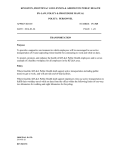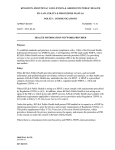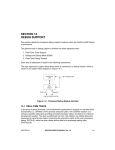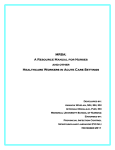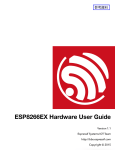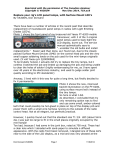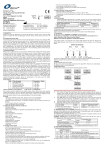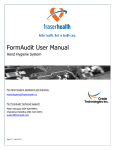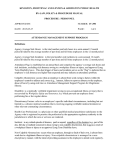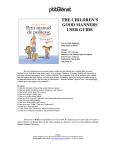Download Service Manual Template
Transcript
KINGSTON, FRONTENAC AND LENNOX & ADDINGTON PUBLIC HEALTH BY-LAW, POLICY & PROCEDURE MANUAL PROCEDURE: PERSONNEL APPROVED BY: NUMBER: IV-435 DATE: 2015-01-13 PAGE: 1 of 5 ROUTINE PRACTICES Definitions Routine Practices (RP): Routine practices (RP) are the basic precautions for preventing transmission of infection in any setting where healthcare is provided. RP recognize that potentially infectious microorganisms are always present on the nose, skin, and throat, and in bodily fluids and excretions and can be transferred from one person to another either directly or indirectly. Elements of RP include hand hygiene (HH), use of personal protective equipment (PPE), respiratory etiquette, environmental cleaning, and safe handling of sharps. Hand Hygiene (HH): A general term that applies to hand washing or the use of alcohol-based hand rub. HH reduces the number of microorganisms on the hands, and is one of the most important practices to prevent the spread of infection to program and service users and staff. Personal Protective Equipment (PPE): Additional clothing or equipment worn by an employee for protection against potentially infectious materials. The selection of gowns, gloves, masks, N95 respirator, or face protection, or combination thereof, should include a risk assessment of the probability of exposure to blood or bodily fluids, mucous membranes or un-intact skin and the probable route of transmission if the cause of illness is known. Respiratory Etiquette: covering your cough and sneezes. Alcohol-based hand rub (ABHR): hand rub that contains a minimum of 70% alcohol. Procedure 1.0 Hand Hygiene (HH) 1.1 Method 1.1.1 Hands shall be washed with soap and water if they are visibly soiled. 1.1.2 If hands are not visibly soiled, the use of an alcohol-based hand rub (ABHR) is the preferred method of hand cleaning and shall be used in all clinical situations. KINGSTON, FRONTENAC AND LENNOX & ADDINGTON PUBLIC HEALTH BY-LAW, POLICY & PROCEDURE MANUAL SUBJECT: Routine Practices Procedure 1.2 1.3 NUMBER: IV-435 PAGE: 2 of 5 Frequency 1.2.1 Hand hygiene shall be performed before: any direct contact with individuals; touching anything in the program and service environment; performing invasive procedures; handling dressings or touching open wounds; preparing and administering medications; preparing, handling or eating food; and breaks. 1.2.2 Hand hygiene shall be performed after: contact with blood, bodily fluids, un-intact skin or mucous membranes; contact with items known or considered to be contaminated; removal of gloves and masks; personal use of a toilet; and blowing or wiping the nose. Technique The surfaces of hands should be scrubbed vigorously for at least 15 seconds with soap or ABHR. 2.0 Personal Protective Equipment 2.1 Gloves 2.1.1 Gloves are used in addition to hand hygiene and are not required for routine care or contact activities where contact is limited to an individual’s intact skin. 2.1.2 Clean, appropriately sized gloves that need not be sterile shall be worn under the following conditions: • When there is contact with blood, bodily fluids, secretions and excretions, mucous membranes, draining wounds or un-intact skin is likely. • When handling items visibly soiled with blood, bodily fluids, secretions or excretions. • When an employee has open laesions on her or his hands. 2.1.3 When worn, gloves shall be: • changed between procedures with the same individual, • put on directly before the task or procedure to be performed, • removed immediately following completion of task at point-of-use and before touching clean environmental surfaces or any clean equipment, and • disposed of immediately after use and not reused. KINGSTON, FRONTENAC AND LENNOX & ADDINGTON PUBLIC HEALTH BY-LAW, POLICY & PROCEDURE MANUAL SUBJECT: Routine Practices Procedure 2.2 NUMBER: IV-435 PAGE: 3 of 5 Gowns or lab coats 2.2.1 Gowns or lab coats are used to protect uncovered skin and to prevent soiling of clothing during procedures likely to generate splashes or sprays of blood, bodily fluids, and secretions and excretions. Gowns are not routinely required during contact or with individuals. 2.2.2 When worn, gowns or lab coats shall be: • appropriately sized with sleeves that extend to the wrist and are cuffed for a snug fit, • removed immediately after completion of the activity requiring their use, and • worn once, with disposable impervious gowns discarded after use and cloth gowns laundered. Lab coats should be changed when visibly dirty and laundered on a regular basis. 2.3 Masks 2.3.1 The Occupational Health Nurse shall be responsible for arranging N95 Mask Fit Testing for Infectious Disease Prevention and Environment Health staff at hire and then every two years, or when there is a change in facial shape such as weight loss or gain. Employees are responsible for arranging retesting due to change in facial shape. All other staff members will be Mask Fit Tested on an as needed basis. Staff may be referred to an alternate source of testing if unable to be Mask Fit Tested using internal testing equipment. Mask type shall be recorded in HRIS. 2.3.2 Masks are worn to protect the mucous membranes of the nose and mouth during procedures likely to generate splashes, sprays, or aerosols of blood, bodily fluids, secretions or excretions. Masks shall be worn when the provider is within two metres of a coughing individual. 2.3.3 Properly fitted N95 respirators shall be used when required for care of patients with tuberculosis, or other serious diseases transmitted by the airborne route, or when directed by their supervisor or the Medical Officer of Health. 2.3.4 When worn, masks shall be: • standard surgical procedure masks, • properly fitted N95 respirators only as described above, and • discarded when the mask is crushed, wet, has dangled around the neck or has become contaminated. KINGSTON, FRONTENAC AND LENNOX & ADDINGTON PUBLIC HEALTH BY-LAW, POLICY & PROCEDURE MANUAL SUBJECT: Routine Practices Procedure 2.4 3.0 4.0 5.0 NUMBER: IV-435 PAGE: 4 of 5 Eye Protection 2.4.1 Eye protection is worn to protect the mucous membranes of the eyes during procedures likely to generate splashes, sprays or aerosols of blood, bodily fluids, secretions or excretions. Prescription eyeglasses are not considered eye protection as they do not provide adequate protection, from splashes or sprays. 2.4.2 When worn, eye protection shall: • fit over prescription glasses, and • be removed in a manner that avoids self-contamination. Respiratory Etiquette 3.1 Respiratory etiquette is used to minimize the spread of respiratory organisms and shall be practised at all times. 3.2 Techniques • Coughs and sneezes should be into the elbow or upper sleeve, not into hands. • The mouth and nose should be covered with a tissue when coughing or sneezing; the tissue should be discarded immediately, and hands should be cleaned. Environmental Cleaning 4.1 Appropriate cleaning, disinfection, and sterilization of reusable care equipment, including toys, are required to prevent the transmission of organisms between individuals. 4.2 Frequency • Visibly soiled equipment shall be cleaned immediately. • Items shared routinely shall be cleaned between individuals. • A regular cleaning schedule shall be established and shall include assignment of responsibility and accountability for cleaning. 4.3 Staff responsible for cleaning contaminated equipment shall: • wear PPE appropriate to the task to protect themselves from exposure to potential pathogens and chemicals, and • be properly trained to conduct the cleaning safely and effectively. Safe Sharps Handling 5.1 Safe sharps (e.g., used needles, used razors) handling is used to avoid injuries and minimize the spread of infection and shall be practised at all times. KINGSTON, FRONTENAC AND LENNOX & ADDINGTON PUBLIC HEALTH BY-LAW, POLICY & PROCEDURE MANUAL SUBJECT: Routine Practices Procedure 5.2 6.0 NUMBER: IV-435 PAGE: 5 of 5 Techniques • Used sharp items shall be disposed of by the user immediately in designated puncture resistant containers located in the area where the items were used. • If a sharp instrument is found, it should not be picked up with bare hands. Instead, the area where the sharp instrument is located should be blocked off, and trained maintenance staff contacted to dispose of it safely. Training and Support 6.1 All employees, volunteers, and students shall be made aware of RP during orientation. 6.2 Ongoing RP support and expertise is the primary responsibility of the agency’s Infection Control Professional on the Communicable Disease team. The Occupational Health Nurse may provide additional support. 6.3 All employees, volunteers, and students shall assist visitors and program and service users with regard to hand hygiene and respiratory etiquette. ORIGINAL DATE: 25 September 2013 REVISIONS: REVIEW DATE: 2015-01-13






